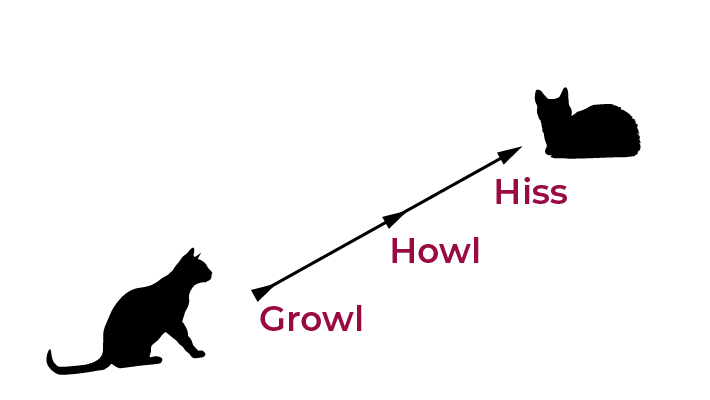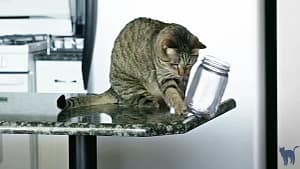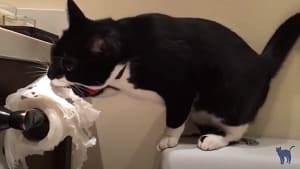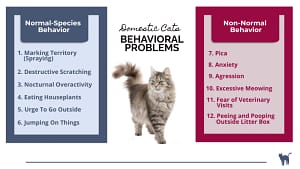Here’re the 9 most common sounds and noises cats make, and their 7 different meanings:
- Meow: speaking with humans;
- Trill: greetings and welcome;
- Chatter: calls for prey;
- Purr: happiness and satisfaction;
- Caterwaul: seduction;
- Growl: fear, hostility, and rejection;
- Howl or yowl: fear, hostility, and rejection;
- Hiss: fear, hostility, and rejection;
- Scream or cry: pain and confusion.
There’s an estimate of 480 million stray cats and 220 million owned cats in 2021, according to Wikipedia.
Geographically speaking, a statistic measured by MacNamee in 2017 showed that the numbers of cats kept as pets are…
- 95.6 million in the United States,
- 10 million in Canada,
- 10 million in the United Kingdom,
- 3 million in Australia, and
- 1.5 million in New Zealand.

Despite having sooo many pet cats in the world and having domesticated them around 7500 BC… owners still struggle with interpreting the way cats communicate with them. Especially when it comes to the sounds they make.
Cats lack facial expressions and are generally quiet and impenetrable. And they express themselves through sounds when they want to communicate something. It’s their only way of letting us know what their feelings and emotions are.
Your feline friend makes different sounds depending on the situation. Each noise with multiple nuanced variations is determined by relevancy. Some express contentment and peace, while others show concern, dread, or even fury.
It is important to note that cats have the most vocalizations of any domestic pet, second only to birds.
Have you ever wondered how many different sounds your cat can make? According to experts, there could be more than 100!
Understanding what your pet is trying to say is very important: it allows you to better interpret your feline friend’s feelings and emotions.
With this handy guide, you’ll have an answer to the question most cat owners have: What do different cat noises mean?
By reading this article, you are going to discover 9 of the most prevalent ones and the meaning behind them. So, you’ll be able to translate what your cat is telling you like a pro!
Let’s start…
What Do Different Cat Noises Mean? (long answer)
In nature, cats are solitary animals who rarely seek the company of other cats. Still, they can live together in friendly groups, as you already guessed.
In this sense, they are social creatures who communicate in four different ways:
- Olfactory signals: through smell (spray and rub);
- Visually: with postures and body movements;
- Tactilely: through touch;
- Vocally: with sounds.
If you are interested in delving into this argument, this article could interest you:
Can Cats Communicate With Each Other? Here’s What You Should Know
In this post, we’ll focus on the last type of cat communication: various cat noises and their meanings.
Purposes of Cat Vocalization
7 Purposes of Cat Vocalization
Speaking With Humans
Meows
Greetings and Welcome
Trills
Calls for Prey
Chatters
Happiness and Satisfaction
Purr
Seduction
Caterwaul
Fear, Hostility and Rejection
Growl, Howl or Yowl, Hiss
Pain and Confusion
Scream or Cry
Not all cats make noises though. Many prefer to remain silent, a predatory instinct they never get rid of despite becoming domesticated.
When cats feel vulnerable, they hide both physically and emotionally.
It mostly happens in 3 situations:
- when they are sick;
- when they are in pain; or
- when they are giving birth.
In some particular situations yet, cats communicate with others through sounds. This happens when they are away from home at night, for example.
Sounds are useful for addressing messages across great distances or when visibility is limited. We’ve all heard the nightly sound concerts in the spring season.
Meow seems to be an all-purpose sound when it comes to addressing a message to humans.
Meow is the first sound a kitten makes.
Newborn kittens meow because they are born with their eyes closed and they are trying to tell their mothers they need help.
It happens especially when they are cold, hungry, or struggling to find the mother’s nipples.
As wild kittens develop, their youthful vocalization disappears.
Instead, domesticated cats continue these lovely sounds throughout their adult life.
Have you ever wondered why? The simple answer is because in our world, they never grow up, and they see themselves as our eternal children.
The meow sound is perpetuated for the rest of their life only because we give them attention. This is astonishing! Cats know it works, so they keep doing it.
In fact, cats have learned that meowing is the best and quickest way to get what they want.
Speaking With Humans
# 1 Meow
When it comes to the question: What do diverse cat meows mean? The answer is not as straightforward as you’d like.
The reason is that meows have more than one meaning.
In fact, a meow conveys information about cats’ emotions and the urgency of their “message.”
The sound comes in a variety of forms and cats use it in a lot of situations. A meow can be: commanding, persuading, demanding, inviting, imperious, melancholy, sad, suffering, friendly, brave, or fearless.
In general, the stronger the meow, the more intense the emotion.
Every cat has its own unique meowing style. Still, we can categorize some of the more heard types:
The standard meow
These meows have a mid-length duration and a mid-pitch tone. This type is the most familiar because it’s the most common one!
In general, when you hear it, it’s because your cat is requesting something. Then it’s up to the context to figure out what that want is.
The ‘mewl’
The long, drawn-out meow
This type suggests that your pet has a special desire. It’s possible they’re reminding you of dinnertime or that they’d like to go outside.
Most cat owners complain that this type of meow wakes them up in the middle of the night or even early in the morning when cats are hungry.
Reiterated meows
Sharp meow
This type of meow often sounds more like a scream due to the high pitch, and that’s often what it means!
Your cat will emit a high-pitched meow when it’s suddenly startled or hurt.
Low-tone meow
This meow can be interpreted as a complaint. It’s more of a continuous complaint than a request for attention!
You may overhear this after-dinner hour and the food bowl is still empty.
Generally, a meowing pet wants to communicate one of these things:
- Attention or food,
- Access to a room,
- Welcome home greeting,
- Desire to play,
- Loneliness,
- Worry, annoyance, or objection to something,
- Illness or injury.
If your pet meows all night, and you’d like to learn more about it, you might be interested in those posts:
- Why Does My Cat Meow All Night? [11 Reasons You Must Know]
- How to Get My Cat to Stop Meowing at Night [6 Proven & Easy Ways]
Though it may be unbelievable, it is suspected that meows may even have geographical variances.
And the root cause may be different languages humans speak around a cat.
Greetings and Welcomes
# 2 Trills
Trilling is a chirpy, high-pitched sound mostly made by female cats. The mother makes this sound to encourage her kittens to follow her or to get their attention. Adults use it as well as a friendly welcome to other cats or humans.
The trilling sound usually indicates a happy emotion or a welcome mood. It occurs when your feline friend is happy or excited. It’s also its way to say “hello”, “yes, got it” or “thanks”.
Your pet may use it to:
- Get your attention;
- Make you see something that he/she considers important;
- Let you know it is glad to see you when you get home;
- To show it is pleased to relax on the couch;
- To tell how excited it is for the food you’ve provided.
Calls for Prey
# 3 Chatter
Cats make this sound when their gaze is focused on prey and there is an obstacle between them, such as a window. It is a series of high-pitched sounds made by a trembling cat’s jaw.
There are two theories about this sound:
The first one believes it is just predatory enthusiasm. They get excited about observing their hunt and feel frustrated by not being able to catch it.
The second claim is that chatter is a hunting strategy. Cats may imitate bird or rodent calls to mislead victims into a false sense of security. This behavior allows them to remain hidden for as long as possible.
If you have ever seen felines hunting, you’ll notice how silent they are, they do not even crush the grass. I do believe all felines know that their hunting success is dependent on silence and stealth.
Happiness and Satisfaction
# 4 Purr
Purring is one of the other most common cat sounds. And for any cat owner, it is the most pleasant one.
But how much do we know about this interesting sound? Scientists and experts have dedicated many studies to it.
Mothers use purring to communicate with their kittens since they are born deaf and blind. Still, they can detect vibrations from their mother’s purr. This is how they get the milk they need to survive. Also, kittens purr while breastfeeding as they feel confident and happy.
Experts believe that mothers use it since predators cannot hear the purr because it is a very low sound.
Adult cats, on the other hand, purr when they are joyful and feeling well. Some examples are when the cat makes contact with another cat or human when it rubs against an object or “kneads” a blanket.
Yet, on rare occasions, cats purr in circumstances that are not pleasant.
They use it to show:
- Agitation,
- Worry, or
- Even pain.
For example, they purr during a visit to the vet, when they are sick or in pain, during delivery, or even when they are on the point of death.
So the purr most likely expresses intense emotions, pleasant or not… and interpreting this exact meaning often comes down to context.
According to scientists, purring generates endorphins that help them relax. Additionally, the frequencies a purr produces induce both bone and tendon regeneration.
Since in nature cats spend a lot of time waiting to hunt, purring helps activate bones and tissue growth. That keeps them from becoming weak and having their bones brittle.
Research has found that purring is used as a mechanism for cats to soothe and heal themselves. Isn’t it amazing?
As a result of these studies, Purr-like vibration devices have been patented for therapeutic use.
And some researchers promote their use in space voyages as a remedy to help astronauts maintain their bone density. How cool is that?
Seduction
# 5 Caterwaul
Caterwaul is the sound that females in heat use to attract a future sexual mate.
Male cats do not go into heat. So the only mate thanks the scents and sounds a female in heat produces.
Males flock to this call, and we may hear hostile sounds like howling, growling, or yelling. What’s happening is that rivals are competing in this strange sound concert to see who can mate with the female.
This loud, sad meowing comes in a variety of tones. Some sounds are short, while others are longer. They do, however, have one trait in common. Female cats do it nonstop, over and again, for hours at a time.
These burning desires seem to be particularly intense at night.
By listening closely, we can notice that the seduction calls used by females and the scare-off sounds made by males are very similar. As a result, distinguishing them can be difficult.
Caterwaul sounds are similar to a baby’s cry, which is why we react so strongly when we hear them. They sound so sad! We become worried and feel that they must need our help.
Is it possible to stop your pet from doing this? Sterilizing prevents them from going through this phase.
So if sex calls such as these annoy you, consider spaying or neutering your pets.
Fear, Hostility, and Rejection
We’ve all seen two cats locked in a howling and growling duel with no idea what the outcome would be. This occurs especially when two unaltered cats are fighting over territory or to gain the attention of a female in heat.
But also when a cat is annoyed, frightened, angry, or aggressive or feels some kind of distress, like being stuck in a closet, looking for you, or being in pain. Elder cats may make these sounds because they are disoriented or suffering from dementia.
Females will do the same thing if they don’t like each other, although with less intensity.
When it comes to fighting, cats rarely come into physical conflict with one another. As an alternative, they express their anger through these noise concerts as a mutual warning system.
However, there are times when physical confrontation is the only option. When this happens, the sounds change as the tension rises. The space between them is critical also because the closer they get, the more tension builds up.
These are the three most common sounds during this process:
- Growl;
- Howl or yowl;
- Hiss.
Let’s see each sound in detail:

# 6 Growl
Growling is typically associated with dogs, but cats have their version of the sound.
They mainly express it when they are angry or scared. When you hear this sound, it means that your cat is warding off a potential threat and giving a firm warning to stay back.
Cats growl at each other to say, “Back off before I have to use my claws!”
They might also be expressing:
- “I don’t like this situation”,
- “I don’t like you”,
- “I don’t like something around me”.
For example, if your pets growl at each other during mealtime, they might be worried about another cat stealing their food. You may solve this problem by placing each bowl at a suitable distance.
# 7 Howl or Yowl
This is a loud and persistent sound used to convey anxiety and discomfort. For instance, in territorial disputes or mating problems.
It is a long-lasting and repeated sound whose aim is to show fear and persuade the “enemy” to retreat.
Growl-howl or howl-growl is a common combination of these sounds. A growl could change into a howl during a rising melody and then back to a growl as the melody lowers.
The howl and yowl may also have different meanings. Many of these noises are context-specific.
Here is a list of probable causes for why cats make this sound:
- Territorial issues;
- Mating disputes (in non-neutered cats);
- When the cat is distressed;
- When the cat is in pain and scared (an injured cat means that it is more likely to be eaten in the wild);
- When someone approaches and the cat wants to keep them away;
- When the cat’s trapped inside a cabinet and asks for your help (come find me, I’m here …);
- When elder cats or cats suffering from feline dementia feel disoriented (especially at night);
- When something in the cat’s environment irritates him, perhaps a new cat on the block.
Cats who moved to new territory frequently howl their frustration. They miss their previous place.
Long howling and yowling concerts are typical when two cats meet in the garden of one of them. Still, they may also howl out of boredom in some cases.
Some cats may use this sound in the wrong way. Each pet is unique, and its usage will be determined by how it was raised. For example, if your cat was fed by us (humans) from birth, the kitten may not be able to use it properly.
The point is, the context in which he or she will start using a sound depends on the situations it had worked in the past. This means that your pet may be yowling for no clear reason.
If your feline friend is not neutered yet, I recommend you do it as soon as possible, especially if you are letting it go outside. Also, make sure your cat has enough toys and you are giving him or her the proper attention.
Sometimes, only one extra play session per day is all that is necessary to put an end to a case of disturbing howling.
# 8 Hiss
The purpose of a hiss is obvious. Hissing is a common way for cats to express their fear. It’s their way of saying, “Back off, or I’ll have to attack you”. Because cats avoid confrontation at all costs, hissing is generally the first line of defense.
The following circumstances cause a hiss:
- A mother is trying to protect her kitties,
- A mother warns her kittens to stop doing something,
- The vet is trying to examine your pet,
- A dog becomes overly friendly
- There are territorial issues between cats,
They also hiss as an involuntary reaction when you touch a sensitive or painful part of him or her.
When hissing, a cat changes its body language altogether. You can notice it because it has puffy fur, a wobbly tail, flattened ears, an open mouth, and fangs READY to strike.
A cat’s hiss is strongly affected by its perception of the environment. Friendly and outgoing pets virtually never hiss, but a more shy and quiet cat will do it more frequently when he or she does not feel comfortable.
Stray, feral, or mistreated cats are far more inclined than a friendly, domesticated pet to engage in “hissing mode.”
Pain and Confusion
# 9 Scream or Cry
It’s a loud and high-pitched sound generated just before or during a violent fight. Humans are extremely sensitive to this sound.
The reason for this is that its frequency bands are identical to those produced by our babies when they cry and scream. This is why we wake up when we listen to cats at night.
The most common reasons for crying or screaming are:
- When the cat is severely ill or in great pain;
- When you accidentally stomp on its foot or tail;
- When the male cat, at the end of the mating ritual, pulls his penis from the female vagina;
- Before or during a physical attack;
- As a final warning to scare or drive away from the opponent.
These primal screeches are often followed by an ominous and long howl. They usually precede the physical attack, such as a paw strike or a harsh bite. Non-neutered cats are more likely to fight, especially if they want to mate with a female in heat.
But neutered ones also actively defend their territories. If you want to prevent your cat from joining these fights, you can choose between two options.
You can either keep your pet indoors (especially at night) or…
…you can neuter it, so it will become less aggressive and less likely to look for fights.
Conclusion
Whatever your cat is trying to tell you, the key thing is that you have to listen to it.
I’m sure this article will help you to recognize the common language of cats. Remember that your cat is a unique individual, so it is also important to recognize his own sounds.
At this point, you can better predict your cat’s mood, intentions, and desires. And also be better able to give them what they need, whether they are hungry, sick, happy, lonely, playful, or angry.
Knowing the meaning of the most common cat sounds is a crucial step in building a stronger bond with your feline friend.
If you have come this far and read the entire article, congratulations! You are an excellent cat owner.











